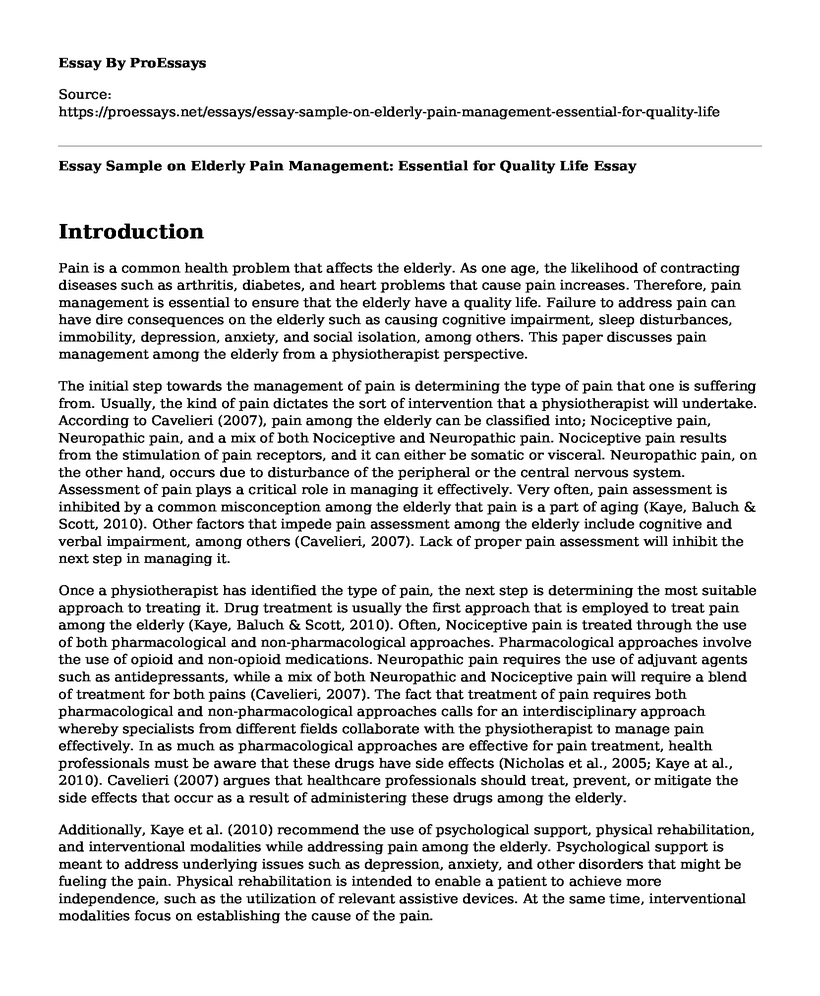Introduction
Pain is a common health problem that affects the elderly. As one age, the likelihood of contracting diseases such as arthritis, diabetes, and heart problems that cause pain increases. Therefore, pain management is essential to ensure that the elderly have a quality life. Failure to address pain can have dire consequences on the elderly such as causing cognitive impairment, sleep disturbances, immobility, depression, anxiety, and social isolation, among others. This paper discusses pain management among the elderly from a physiotherapist perspective.
The initial step towards the management of pain is determining the type of pain that one is suffering from. Usually, the kind of pain dictates the sort of intervention that a physiotherapist will undertake. According to Cavelieri (2007), pain among the elderly can be classified into; Nociceptive pain, Neuropathic pain, and a mix of both Nociceptive and Neuropathic pain. Nociceptive pain results from the stimulation of pain receptors, and it can either be somatic or visceral. Neuropathic pain, on the other hand, occurs due to disturbance of the peripheral or the central nervous system. Assessment of pain plays a critical role in managing it effectively. Very often, pain assessment is inhibited by a common misconception among the elderly that pain is a part of aging (Kaye, Baluch & Scott, 2010). Other factors that impede pain assessment among the elderly include cognitive and verbal impairment, among others (Cavelieri, 2007). Lack of proper pain assessment will inhibit the next step in managing it.
Once a physiotherapist has identified the type of pain, the next step is determining the most suitable approach to treating it. Drug treatment is usually the first approach that is employed to treat pain among the elderly (Kaye, Baluch & Scott, 2010). Often, Nociceptive pain is treated through the use of both pharmacological and non-pharmacological approaches. Pharmacological approaches involve the use of opioid and non-opioid medications. Neuropathic pain requires the use of adjuvant agents such as antidepressants, while a mix of both Neuropathic and Nociceptive pain will require a blend of treatment for both pains (Cavelieri, 2007). The fact that treatment of pain requires both pharmacological and non-pharmacological approaches calls for an interdisciplinary approach whereby specialists from different fields collaborate with the physiotherapist to manage pain effectively. In as much as pharmacological approaches are effective for pain treatment, health professionals must be aware that these drugs have side effects (Nicholas et al., 2005; Kaye at al., 2010). Cavelieri (2007) argues that healthcare professionals should treat, prevent, or mitigate the side effects that occur as a result of administering these drugs among the elderly.
Additionally, Kaye et al. (2010) recommend the use of psychological support, physical rehabilitation, and interventional modalities while addressing pain among the elderly. Psychological support is meant to address underlying issues such as depression, anxiety, and other disorders that might be fueling the pain. Physical rehabilitation is intended to enable a patient to achieve more independence, such as the utilization of relevant assistive devices. At the same time, interventional modalities focus on establishing the cause of the pain.
Conclusion
In conclusion, pain among the elderly is a common problem. Physiotherapists and other healthcare specialists have to ensure that this challenge is addressed adequately to improve the quality of an elderly patient's life. Tackling pain among the older population requires a multidimensional approach that involves pharmacological and non-pharmacological approaches as well as collaboration between different specialists. Furthermore, effective management of pain should be preceded by a proper assessment of the cause of pain.
References
Cavelieri, T. (2007). Managing pain in geriatric patients. The Journal of the American Osteopathic Association,107, 10-16
Kaye, A., Baluch, A. & Scott, J. (2010). Pain management in the elderly population. The Ochsner Journal, 10(3), 179-187.
Nichols K., Galluzzi K., Bates B., Husted B., Leleszi J. &, Simon K, et al. (2005). AOA's position against the use of placebos for pain management in end-of-life care. Journal of American Osteopath Association, 105(1),2-5
Cite this page
Essay Sample on Elderly Pain Management: Essential for Quality Life. (2023, May 07). Retrieved from https://proessays.net/essays/essay-sample-on-elderly-pain-management-essential-for-quality-life
If you are the original author of this essay and no longer wish to have it published on the ProEssays website, please click below to request its removal:
- Intervention for Children With Synethesia: The Girl Who Heard Colors Essay
- Essay on Cultural Empowerment of Children with Obesity
- Essay Example on Harmful Behaviours by Health Workers: What is Acceptable?
- Essay Example on Primary Hypertension: Modifiable & Non-modifiable Risk Factors
- Argumentative Essay Sample on Rule Util & Euthanasia: Is Prolonging Life Morally Right
- Paper Example: International Disaster Risk Factors
- Paper Sample: Engagement in Professional Nursing







